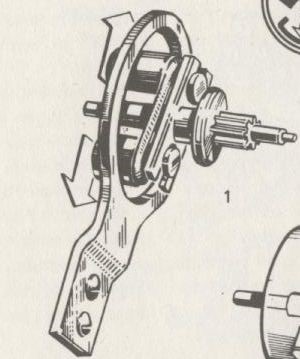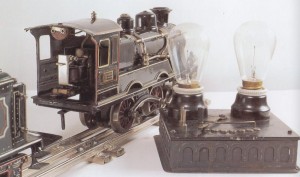ENGINE PROPULSION SYSTEMS AND REVERSING UNITS FOR MÄRKLIN GAUGE 1 AND 0

INTRODUCTION
When Wilhelm Märklin established the firm Märklin in 1859, the main products included doll kitchens and other general metal toys. It was not until 1891 that the first trains appeared in the assortment of their products. Engine power was still in its infancy with floor-runners. Soon however, Märklin started to produce powered locomotives for their trains. Clock-work, steam, and even electric power were the main propulsion systems for the trains. The makers of toy trains had to deal with overwhelming problems:
Electricity had arrived in many households in the late 1800s. The electric power was distributed by many independent, often small, suppliers and varied from 220V, 110V alternating or direct current, to even three-phase current.
Toy train manufacturers had to provide the necessary electric power for their engines. The electric motors for these engines were often rather large and cumbersome as the wiring for the field- and rotor magnets was cloth-insulted thin copper. Transformer techniques were still in their infancy. Needless to say all these factors posed significant problems for the manufacturers. This article discusses how Märklin dealt with such problems over the years, until the arrival of their 00 (later H0) system. The different power supplies for the track (batteries, transformers, rectifiers etc.) are not specifically discussed in this report.
CLOCKWORK
Märklin introduced its first clockwork locomotives as early as 1891 in gauge 1, after having taken over the Lutz Company. These locs had a simple clockwork mechanism. When wound, they shot forwards and immediately derailed on the sharply curved track. This could be prevented by hooking up some heavy cars.
Märklin improved the spring-driven clockwork system in 1910 by adding an ingenious “brake-system”, a regulator built in with the loc, which consisted of a small cylinder or ring, containing spring-held brake-shoes pressing against the inside of the cylinder, which were gradually spring-released when the power of the mainspring decreased, thereby allowing the engine to run at approximately the same speed until the mainspring was unwound.
The clockwork mechanism had become stronger, allowing for longer running-time. A special “Kraft-wagen” (power-car) was added for gauge 1 in 1909. This car could be run in the middle of longer trains and had its own clockwork to assist the locomotive in long, heavy hauls.
There were even clockwork engines that had two clockwork motors, first built in 1909.
In 1909 Märklin introduced clockwork engines in gauge 1 with headlights, the electric power was generated by means of a dynamo built into the engine.
Märklin continued to produce clockwork engines until the very end of their gauge 0 assortment in 1954 with a simple 0-4-0 steam loc.
All other clockwork engines were taken off the production line around 1935 when electric engines and transformers were being built to perfection.
STEAM
The first live steam driven engines, built as early as 1895, were “dribblers” as they continuously leaked water vapor from their cylinders. Later engines had very sophisticated steam-engines as propulsion power, which were often heated by gas-burners. The engines were built for gauges 1 and 0. These beautiful models were produced until 1935 when electrical propulsion systems had become reliable and safe.
ELECTRICITY
Electrical power was not introduced in most households in Germany until the early part of the 20th Century.
Even then, there was complete chaos in power supplied to the households as it was provided by many small independent suppliers, which supplied the households with 110V or 220V, AC or DC, or even 3-phase current. Electricity was introduced in Göppingen (where the Märklin factory was located) in 1900. It was not until 1926 that household voltage became regulated.
For toy-train manufacturers this chaos posed significant challenges. Besides, the development of transformers was still in its infancy.
In addition, the development of electric motors for toy trains had its own problems. The copper wire used in the windings of field magnets and rotors had cloth winding as insulation. This resulted in rather large electric motors.
To further complicate the development of these motors, it was customary to use the shell of the clockwork engine to save on extra expense and to build the electric motor inside the available space.
From the mid-thirties onward Märklin had developed good and reliable 20V transformers. For that reason the need for clockwork- and steam engines diminished and new engine models were mostly produced as electric engines only.
THE DIFFERENT TYPES OF ELECTRICALLY POWERED ENGINES
Low current (4V DC) electric motors were used as engine power as early as 1900.
These motors were powered by large batteries (“accu”), which was the only power readily available. They were used in gauge 1 and gauge 0 engines.
The 4V DC motor with permanent magnet was compatible in space with clockwork motors. Replacement of the clockwork motor with an electric 4V motor was available!
The advantage of these motors was of course the much longer running time of the engine, and the easy reversing by changing the polarity of the power.
The disadvantage of these motors was the low pulling power, less so than the live steam or clockwork engine. In addition the power supply (battery) had a restricted lifespan.
High voltage (“Starkstrom”) electric motors were installed in existing loc shells used for clockwork between 1904 and 1926. The size of these motors was dictated by the motor-frame distance (used for clockwork) in the existing engines. This was by no means an easy task as the available wiring of the field magnet and rotor consisted of thin copper wire covered in cloth wire for insulation, resulting in a rather voluminous motor.
That meant some, often strange looking, adaptations in the engine to accommodate the larger electric motor.
Electric power was derived from the existing 110 or 220V household current, with light bulbs to reduce the voltage to approximately 50V. When derailments occurred (or even when the power was turned off) the full 220V could be on the track.
The newly formed Electrical Regulatory System (VDE) prohibited the use of these dangerous techniques in 1926. From that time onward the engines had only 20V AC or DC electric motors.
REVERSING OF THE ENGINES
Märklin introduced their first 20V AC electric engines in 1927 with at first only a hand-reverse.
Reversing for an AC motor is more complicated than for a DC motor. The reversing can only be accomplished through the rotor-brushes, not through the field magnet.
Transformers were developed that reduced the current to a safe 20V.
The 20V 0-gauge engines had mostly AC motors. These motors could run on either AC or DC power.
In order to change the direction of travel, the “66/-reversing unit” was developed. When the power was on, a secundary electromagnet pulled a metal finger down onto a toggle switch and the engine ran in one direction. When the power was off, the metal finger was released. When the power came on again, the metal finger was again pushed down and forced the toggle switch in the other direction. These switch-maneuvers reversed the flow of power to the brushes.
The remote reversing unit could be deactivated by fastening the direction of travel with a reversing rod which protruded from the back of the engine.
Märklin introduced a DC motor in their 0-gauge (and 00 gauge) engines in 1935. These engines had no hand-reversing lever. Reversing with the so-called “70/-reversing” (Ideal- or Perfect Schaltung) was accomplished with two rectifiers: one between the transformer and the track, the other rectifier was built into the engine.
The quality of the rectifiers was not very high due to the use of poor materials, as higher quality material was needed for the WWII war effort and the rectifiers often started to smell. The competition mockingly referred to these rectifiers (in German: Gleichrichter) as “Gleich riecht er”, meaning “he smells right away”.
Reversing of the AC motor in Märklin’s H0 gauge engines is accomplished by having two counter-wound windings in the field magnet. A separate reversing unit with a built-in electromagnet switches the power by means of a higher voltage burst which activates a finger to switch the power from one winding to the other, thereby reversing the direction of the engine (the Perfect-Schaltung 800).
Further discussion on the engine power in Märklin’s H0 line is omitted in this report.
IDENTIFICATION OF THE ELECTRIC ENGINE POWER IN THE ENGINE
Märklin used symbols in the form of painted flashes on the front side of the electric engines to identify the nature of the electric motor in the engine:
Yellow flash: Starkstrom (50V)
Green flash: 4V DC
Red flash: 20V AC. The engines were equipped with a reversing rod protruding from the back of the engine cab for manual reversing, used both in engines with the 66/ reversing and in engines without this remote reversing unit.
Many engines from the 1930s have a small metal placard with “B” inscribed on the side of the cab. This “B” is a recommendation from Marklin of what transformer to use. A locomotive that has a “20 Volt B” placard can be run, for instance, with the 13470 B transformer.
These engines had no manual reversing rod.
REFERENCES
The following textbooks were consulted for this study:
- Becher, K. Als die Züge fahren lernte. Verlag für Verkehrswegen, 1979
- Becher, U., Reiche, W. Modellbahn Technik. Leipzig, DDR. 1981
- Cantz, H. Märklin Mythos Modelleisenbahn.. Hatje Cantz Verlag, 2003
- Eckert, K. Die Legende lebt. 150 Jahre Märklin Klartext Verlag, 3009
- Kampman, J.
- Märklin Chronik: 125 Jahre Märklin Mikado Verlags-und Vertriebs-Gmbh., 1984
- Koll, J., Schiffmann, R. Wertanlage Märklin Augustus Publ. 1996
- Marsh, H. Carlson, P. Cristie’s toy trains. Watson –Guptill Publications, 2002.















Outstanding article.
Hi Paul. Just a couple of interesting historical notes. Marklin was still offering the HO gauge S870 clockwork set in the 1956 catalog, so clockwork production probably continued beyond 1954.
And yes, live steam engines recommenced production in 2000 with the appearance of the 55001, and the gorgeous 55003 S3/6 in 2005. These were not directly offered for sale in the USA as Marklin feared the potential litigation costs of burns (I was told this by Marklin’s USA legal counsel). Regards, Brian.
Thank you for your remarks.
I did not want to delve too deeply into the Marklin H0 propulsion systems.
It is true that Marklin introduced a clockwork engine (S870) for their H0 gauge line in 1956.
Their post-war 0-gauge production, which included a small clockwork steam engine, however was discontinued in 1954.
The “new” gauge 1 line has indeed a totally different propulsion system with DC motors, even live steam.
My article concentrated on the old (largely pre WWII) locomotive power systems for the old gauge 1 and gauge 0.
Bert van Helden
An excellent and most interesting piece of research. The idea of using 220 volts to power toy motors boggles the mind. The lawyers must have had a field day.
Thank you for your kind words.
The 220V was supposedly brought down to a (?harmless?) 50 V by having special lightbulbs between the 220V power and the track. The motors of the engines ran on 50V max. However, with derailments (and who could run such trains without derailments?) the full 220V could be on the track!
As with real toy steam-engines, electric stoves for girls, lead toy soldiers, the world of toys was not especially geared towards safety. But I doubt that lawyers were ever engaged to sue Marklin for the child having set fire to the house, burning or shocking the child or providing poisenous lead toys…
Are WE becoming too overprotective????
Bert
Very interesting article thank you.
One point. I have a loco which is marked 4V and which I have running reasonably well on 4 volts DC at about 0.6 amps. The engine is green with a yellow flash and has 294 on it. That doesn’t fit with your statement that a yellow flash is for 50V locos rather than 4V.
The motor didn’t work initially because the magnet needed remagnetising. I used a length of mild steel strip and 4 off 10mm diameter by 4mm thick neodymium magnets to create enough magnetism for the motor to work. With the magnets and strip installed on the top of the motor, the motor still fits into the loco body. I would have preferred remagnetising the original magnet but don’t know how to dismantle the motor without damaging it.
Thanks again for your fascinating article.
Harry
wie kan ich finden ein marklin motor fuer lokomotive no.3738 br 128 mich fruen daruber
wen sie ein motor fuer mich finden koenten.recht schoen dank foraus